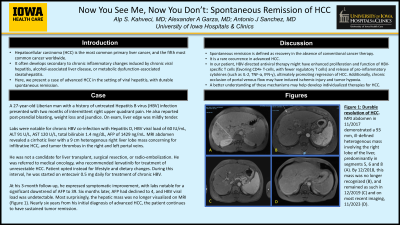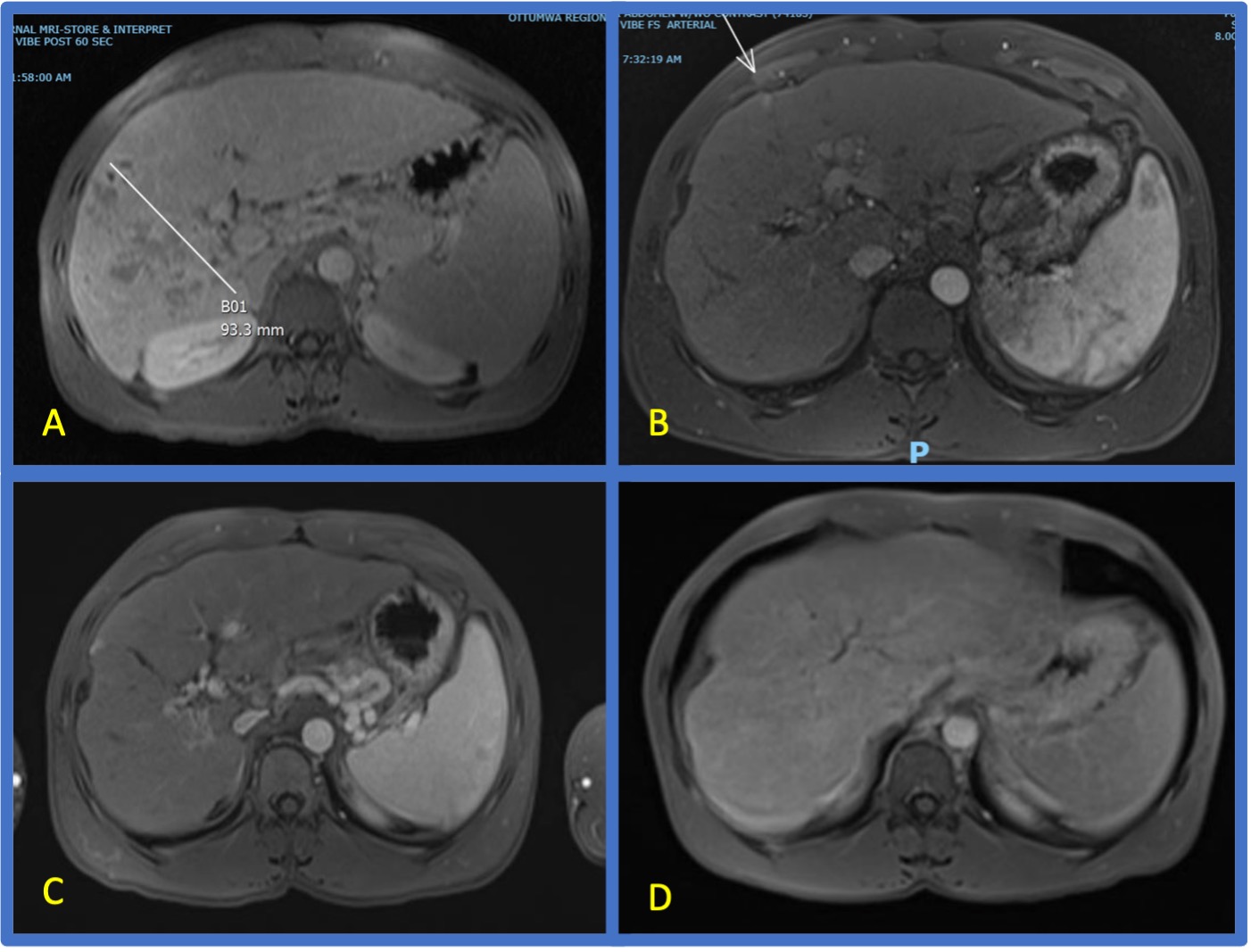Sunday Poster Session
Category: Liver
P1261 - Now You See Me, Now You Don’t: Spontaneous Remission of HCC
Sunday, October 27, 2024
3:30 PM - 7:00 PM ET
Location: Exhibit Hall E

Has Audio
- AK
Alp Kahveci, MD
University of Iowa Hospitals & Clinics
Iowa City, IA
Presenting Author(s)
Alp Kahveci, MD, Alexander A. Garza, MD, Antonio J. Sanchez, MD
University of Iowa Hospitals & Clinics, Iowa City, IA
Introduction: Hepatocellular carcinoma (HCC) is the most common primary liver cancer, and the fifth most common cancer worldwide. It often develops secondary to chronic inflammatory changes induced by chronic viral hepatitis, alcohol-associated liver disease, or metabolic dysfunction-associated steatohepatitis. Here, we present a case of advanced HCC in the setting of viral hepatitis, with durable spontaneous remission.
Case Description/Methods: A 27-year-old Liberian man presented with two months of intermittent right upper quadrant pain. He also reported post-prandial bloating, weight loss and jaundice. He had a history of untreated Hepatitis B virus (HBV) infection. On exam, liver edge was mildly tender. Labs were notable for chronic HBV co-infection with Hepatitis D, HBV viral load of 60 IU/mL, ALT 91 U/L, AST 120 U/L, total bilirubin 1.4 mg/dL, AFP of 1429 ng/mL. MRI abdomen revealed a cirrhotic liver with a 9 cm heterogenous right liver lobe mass concerning for infiltrative HCC, and tumor thrombus in the right and left portal veins. He was not a candidate for liver transplant, surgical resection, or radio-embolization. He was referred to medical oncology, who recommended lenvatinib for treatment of unresectable HCC. Patient opted instead for lifestyle and dietary changes. During this interval, he was started on entecavir 0.5 mg daily for treatment of chronic HBV. At his 3-month follow-up, he expressed symptomatic improvement, with labs notable for a significant downtrend of AFP to 39. Six months later, AFP had declined to 4, and HBV viral load was undetectable. Most surprisingly, the hepatic mass was no longer visualized on MRI (Figure 1). Nearly six years from his initial diagnosis of advanced HCC, the patient continues to have sustained tumor remission.
Discussion: Spontaneous remission of cancer is defined as patient recovery in the absence of conventional cancer therapy. It is a rare occurrence in advanced HCC. Several mechanisms have been proposed, including systemic inflammatory responses and tumor hypoxia. In our patient, HBV-directed antiviral therapy might have enhanced proliferation and function of HBV-specific T cells (favoring CD4+ T-cells, with fewer regulatory T cells) and release of pro-inflammatory cytokines (such as IL-2, TNF-α, IFN-y), which ultimately promoted regression of HCC. Additionally, chronic occlusion of portal venous flow may have induced ischemic injury and tumor hypoxia. A better understanding of these mechanisms may help develop individualized therapies for HCC.

Disclosures:
Alp Kahveci, MD, Alexander A. Garza, MD, Antonio J. Sanchez, MD. P1261 - Now You See Me, Now You Don’t: Spontaneous Remission of HCC, ACG 2024 Annual Scientific Meeting Abstracts. Philadelphia, PA: American College of Gastroenterology.
University of Iowa Hospitals & Clinics, Iowa City, IA
Introduction: Hepatocellular carcinoma (HCC) is the most common primary liver cancer, and the fifth most common cancer worldwide. It often develops secondary to chronic inflammatory changes induced by chronic viral hepatitis, alcohol-associated liver disease, or metabolic dysfunction-associated steatohepatitis. Here, we present a case of advanced HCC in the setting of viral hepatitis, with durable spontaneous remission.
Case Description/Methods: A 27-year-old Liberian man presented with two months of intermittent right upper quadrant pain. He also reported post-prandial bloating, weight loss and jaundice. He had a history of untreated Hepatitis B virus (HBV) infection. On exam, liver edge was mildly tender. Labs were notable for chronic HBV co-infection with Hepatitis D, HBV viral load of 60 IU/mL, ALT 91 U/L, AST 120 U/L, total bilirubin 1.4 mg/dL, AFP of 1429 ng/mL. MRI abdomen revealed a cirrhotic liver with a 9 cm heterogenous right liver lobe mass concerning for infiltrative HCC, and tumor thrombus in the right and left portal veins. He was not a candidate for liver transplant, surgical resection, or radio-embolization. He was referred to medical oncology, who recommended lenvatinib for treatment of unresectable HCC. Patient opted instead for lifestyle and dietary changes. During this interval, he was started on entecavir 0.5 mg daily for treatment of chronic HBV. At his 3-month follow-up, he expressed symptomatic improvement, with labs notable for a significant downtrend of AFP to 39. Six months later, AFP had declined to 4, and HBV viral load was undetectable. Most surprisingly, the hepatic mass was no longer visualized on MRI (Figure 1). Nearly six years from his initial diagnosis of advanced HCC, the patient continues to have sustained tumor remission.
Discussion: Spontaneous remission of cancer is defined as patient recovery in the absence of conventional cancer therapy. It is a rare occurrence in advanced HCC. Several mechanisms have been proposed, including systemic inflammatory responses and tumor hypoxia. In our patient, HBV-directed antiviral therapy might have enhanced proliferation and function of HBV-specific T cells (favoring CD4+ T-cells, with fewer regulatory T cells) and release of pro-inflammatory cytokines (such as IL-2, TNF-α, IFN-y), which ultimately promoted regression of HCC. Additionally, chronic occlusion of portal venous flow may have induced ischemic injury and tumor hypoxia. A better understanding of these mechanisms may help develop individualized therapies for HCC.

Figure: Figure 1: Durable resolution of HCC. MRI abdomen in 11/2017 demonstrated a 93 mm, ill-defined heterogenous mass involving the right lobe of the liver, predominantly in segment 5, 6 and 8 (A). By 12/2018, this mass was no longer recognized (B), and remained as such in 12/2019 (C) and on most recent imaging in 11/2023 (D).
Disclosures:
Alp Kahveci indicated no relevant financial relationships.
Alexander Garza indicated no relevant financial relationships.
Antonio Sanchez: Abbvie – Grant/Research Support. Boehringer-Ingelheim – Grant/Research Support. Gilead – Grant/Research Support. Inventiva – Grant/Research Support. Ipsen – Advisory Committee/Board Member. Merck – Grant/Research Support. Mirum Pharmaceuticals – Grant/Research Support. Takeda – Grant/Research Support.
Alp Kahveci, MD, Alexander A. Garza, MD, Antonio J. Sanchez, MD. P1261 - Now You See Me, Now You Don’t: Spontaneous Remission of HCC, ACG 2024 Annual Scientific Meeting Abstracts. Philadelphia, PA: American College of Gastroenterology.
